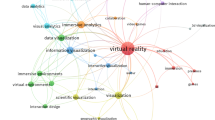Abstract
A wearable computer is a potential platform for map applications: it is mobile in nature, and is often equipped with a head-worn display capable of displaying maps of the surrounding area in graphical form. In this paper, we present a map application, called WalkMap, developed for wearable computers. We concentrate on the visual presentation of the map, and propose a visualisation method that is based on the perspective distortion of a regular two-dimensional bird's-eye view map. We also describe the results of a field study, and compare the distorted view to a regular two-dimensional view. The results show that while a perspective visualisation is good for some navigational tasks, for some other tasks a regular map is preferred. We then continue by developing the visualisation further, and present a fully adjustable three-dimensional version of the map application, called WalkMap3D. WalkMap3D can display the map area in three dimensions, but is also capable of displaying both traditional two-dimensional and perspective map views.













Similar content being viewed by others
Abbreviations
- GLU:
-
OpenGL Graphics System Utility Library
- HWD:
-
Head Worn Display
- LOD:
-
Level of Detail
- VRML:
-
Virtual Reality Modelling Language
- YAH:
-
You Are Here
References
Crampton JW (1988) The cognitive process of being lost. Scien J Orient 4:34–46
Blades M, Spencer C (1987) How do people use maps to navigate through the world? Cartographica 24(3):64–75
Board C (1978) Map reading tasks appropriate in experimental studies in cartographic communication. Canad Cartog 15:1–12
Darken RP, Sibert JL (1996) Wayfinding strategies and behaviors in large virtual worlds. In: Proceedings of the Conference on Human Factors in Computing Systems (CHI), Vancouver, Canada, 13–18 April 1996
Darken RP, Cevik H (1999) Map usage in virtual environments: orientation issues. In: Proceedings of the IEEE Virtual Reality Conference, Houston, TX, 13–17 March 1999
Lehikoinen J, Suomela R (2002) WalkMap: developing an augmented reality map application for wearable computers. VR 6(1)
Lehikoinen J, Suomela R (2002) Perspective map. In: Proceedings of the Sixth International Symposium on Wearable Computers (ISWC), Seattle, WA, 7–10 October 2002
Levine M, Jankovic IN, Palij M (1982) Principles of spatial problem solving. J Exper Psychol 111(2):157–175
Warren DH, Scott TE (1993) Map alignment in traveling multisegment routes. Environ Behav 25(5):643–666
Smailagic A, Siewiorek DP (1994) The CMU mobile computers: a new generation of computer systems. In: Proceedings of IEEE COMPCON, San Francisco, CA, 28 February–4 March 1994
Smailagic A, Martin R (1997) Metronaut: a wearable computer with sensing and global communication capabilities. In: Proceedings of the First International Symposium on wearable computers (ISWC), Cambridge, MA, 13–14 October 1997
Abowd GD, Atkeson CG, Hong J, Long S, Kooper R and Pinkerton M (1997) Cyberguide: a mobile context-aware tour guide. Wirel Netw 3(5):421–433
Yang J, Yang W, Denecke M and Waibel A (1999) Smart Sight: a tourist assistant system. In: Proceedings of the Third International Symposium on Wearable Computers (ISWC), San Francisco, CA, 18–19 October 1999
Feiner S, MacIntyre B, Höllerer T and Webster A (1997) A touring machine: prototyping 3D mobile augmented reality systems for exploring the urban environment. In: Proceedings of the First International Symposium on Wearable Computers (ISWC), Cambridge, MA, 13–14 October 1997
Thomas B, Demczuk V, Piekarski W, Hepworth D and Gunther B (1998) A wearable computer system with augmented reality to support terrestrial navigation. In: Proceedings of the Second International Symposium on Wearable Computers, Pittsburgh, PA, 19–20 October 1998
GeoVRML (2003) http://www.geovrml.org/. Cited 29 January 2003
Kray C, Elting C, Laakso K and Coors V (2003) Presenting route instructions on mobile devices. In: Proceedings of the 2003 International Conference on Intelligent User Interfaces, Miami, FL, 12–15 January 2003
Spoerri A (1993) Novel route guidance displays. In: Proceedings of the IEEE-IEE Vehicle Navigation and Information Systems Conference, Ottawa, Canada, 12–15 October 1993
Suomela R, Lehikoinen J (2000) Context compass. In: Proceedings of the Fourth International Symposium on Wearable Computers, Atlanta, GA, 18–21 October 2000
Furnas GW (1986) Generalized fisheye views. In: Proceedings of the Conference on Human Factors in Computing Systems (CHI), Boston, MA, 13–17 April 1986
Lehikoinen J (2001) An evaluation of augmented reality navigational maps in head-worn displays. In: Proceedings of the Human-Computer Interaction Conference (INTERACT), Tokyo, Japan, 9–13 July 2001
Suomela R, Lehikoinen J and Salminen I (2001) A system for evaluating augmented reality user interfaces in wearable computers. In: Proceedings of the Fifth International Symposium on Wearable Computers (ISWC), Zurich, Switzerland, 8–9 October 2001
MacEachren AM (1995) How maps work? Guildford, New York
Blades M, Spencer C (1987) Map use in the environment and educating children to use maps. Environ Educ Info 5:187–204
Hakala T, Lehikoinen J, Suomela R and Röykkee M (2002) Portable map display system for presenting a 3D map image and method thereof. US Patent 6,452,544 B1, 17 September 2002
Leech J. (ed) (1999) The OpenGL graphics system: a specification (version 1.2.1). Silicon Graphics, Inc. Mountain View, CA
Roimela K (2001) 3D graphics in mobile terminals. Master's thesis, Tampere University of Technology
Acknowledgements
The authors wish to thank Tero Hakala, Mika Röykkee, Aino Ahtinen, Tomi Aarnio, Ilkka Salminen and Antti Aaltonen from the Nokia Research Center.
Author information
Authors and Affiliations
Corresponding author
Rights and permissions
About this article
Cite this article
Suomela, R., Roimela, K. & Lehikoinen, J. The evolution of perspective view in WalkMap. Pers Ubiquit Comput 7, 249–262 (2003). https://doi.org/10.1007/s00779-003-0244-9
Received:
Accepted:
Published:
Issue Date:
DOI: https://doi.org/10.1007/s00779-003-0244-9




